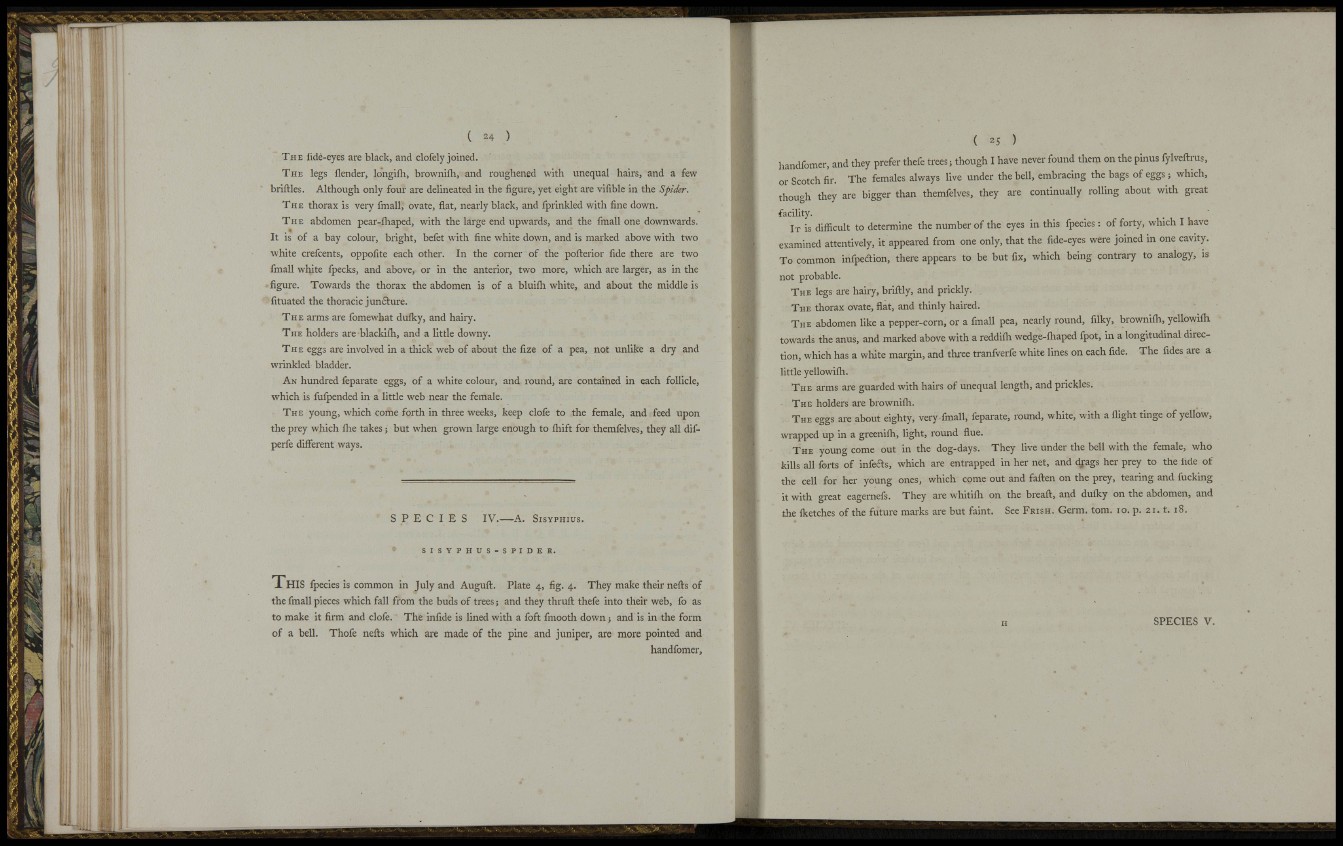
, ' I lil .ilj
( 24 )
THE fide-eyes are black, and clofely joined.
THE legs ilender, longiili, brownifli, and roughened with unequal hairs, and a few
briftles. Although only four are delineated in the figure, yet eight are vifible in the Spider.
THE thorax is veiy fmall, ovate, flat, nearly black, and fprinkled with fine down.
THE abdomen pear-fliaped, with the large end upwards, and the fmall one downwards.
It is of a bay colour, bright, befet with fine white down, and is marked above with two
white crefcents, oppofite each other. In the corner of the pofterior fide there are two
fmall white fpecks, and above, or in the anterior, two more, which are larger, as in the
figure. Towards the thorax the abdomen is of a bluifli white, and about the middle is
fituated the thoracic junfture.
THE arms are fomewhat duiky, and hairy.
THE holders are blackifli, and a little downy.
THE eggs are involved in a tliick web of about the fize of a pea, not unlike a dry and
wrinkled bladder.
AN hundred feparate eggs, of a white colour, and round, are contained in each follicle,
which is fufpended in a little web near the female.
THE young, wliich come forth in three weeks, keep clofe to the female, and feed upon
the prey which Ihe takes; but when grown large enough to fliift for themfelves, they all difperfe
different ways.
S P E C I E S IV.—A. SisYPHius.
( 25 )
handfomer, and they prefer thefe trees; though I have never found them on the pinus fylveftrus,
or Scotch fir. The females always live under the bell, embracing the bags of eggs; which,
though they are bigger than themfelves, they are continually rolling about with great
facility.
IT is difficult to determine the number of the eyes in this fpecies: of forty, which I have
examined attentively, it appeared from one only, that the fide-eyes were joined in one cavity.
T o common infpeftion, there appears to be but fix, which being contrary to analogy, is
not probable.
THE legs are hairy, briilly, and prickly.
THE thorax ovate, fiat, and thinly haired.
THE abdomen like a pepper-corn, or a fmaU pea, nearly round, filky, browniih, yellowifti
towards the anus, and marked above with a reddiih wedge-ihaped fpot, in a longitudinal direction,
which has a white margin, and three tranfverfe white lines on each fide. The fides are a
little yellowiih.
THE arms are guarded with hairs of unequal length, and prickles.
THE holders are brownifli.
THE eggs ai'e about eighty, very fmall, feparate, round, white, with a flight tinge of yellow,
wrapped up in a greenifli, light, round flue.
THE young come out in the dog-days. They live under the bell with the female, who
kills all forts of infefts, which are entrapped in her net, and drags her prey to the fide of
the cell for her young ones, which come out and faften on the prey, tearing and fucking
it with great eagernefs. They are whitifli on the breaft, and duiky on the abdomen, and
the iketches of the future marks are but faint. See FRISH. Germ. torn. 10. p. 21. t. 18.
L! I
S I S Y P H U S - S P I D E R .
T H I S fpecies is common in July and Augufl:. Plate 4, fig. 4. They make their neflrs of
the fmall pieces which fall from the buds of trees; and they thruft thefe into their web, fo as
to make it firm and clofe. The infide is lined with a foft fmooth down; and is in the form
of a bell. Thofe nefts which are made of the pine and juniper, are more pointed and
handfomer.
SPECIES V.